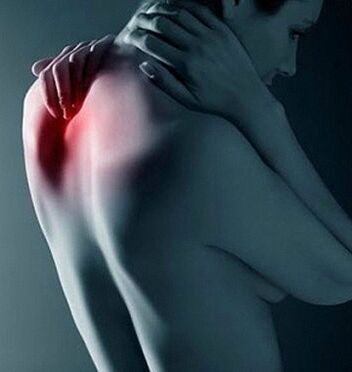Cervical osteochondrosis is considered to be a very common disease that causes degenerative dystrophic changes in the intervertebral discs.In almost 30% of cases, this disease becomes the culprit for severe headaches.The first signs of the disease can occur at the age of 25-40 years.Osteochondrosis in the cervical spine causes serious metabolic disorders.At the same time, the discs lose their elasticity, their strength is also significantly reduced.The risk of the disease is that the changes occurring in the spine become irreversible.Over time, the disease can spread to other departments, cause the development of serious problems, for example, lead to limitation of physical activity, damage.
Symptoms (signs)
The disease has not brought serious discomfort for a long time.One may not assume that he is already developing osteochondrosis, as his first signs are similar to the symptoms of many other diseases.Thinking about this disease is necessary for people who periodically experience:
- Shoulder numbness, hands;
- neck pain;
- Weight in the shoulders.
Another common sign of the disease is characteristic of the neck, which occurs with sharp turns of the head.This shows the changes that have already begun to occur on intervertebral discs.In the future, osteochondrosis of the cervical spine causes the following symptoms:
- severe neck pain, back of the head;
- dizziness;
- Tingling of the fingers on the hands, a feeling of tingling;
- pain under the shoulder blade when tilting the head forward;
- Noise in the ears.
The signs of the disease also include severe fatigue and worsening of hearing.It is very difficult for a person to concentrate because the pain accompanies him during the day and at night.In this regard, the quality of sleep worsens, insomnia occurs.At the short stages of development, osteochondrosis of the cervical spine provokes fatty symptoms associated with the appearance of bone growths.In this case, the vertebrae are connected and immobilized.As a result, a person can no longer freely move his neck, leading to damage.
The causes of the disease
Early osteochondrosis is considered to be age -related, that is, only older people suffer from it. Today, the disease quickly "becomes younger".Recently, the number of patients with osteochondrosis of the cervical spine has increased significantly, the age of 18 to 30 years.The disease can develop for various reasons.However, it most often appears because of:
Today, the disease quickly "becomes younger".Recently, the number of patients with osteochondrosis of the cervical spine has increased significantly, the age of 18 to 30 years.The disease can develop for various reasons.However, it most often appears because of:
- spinal curvature;
- excess weight;
- flat legs;
- traumatic damage to the back;
- Metabolic processes disorders;
- A sedentary lifestyle;
- infectious diseases;
- hard physical labor.
In addition, the disease develops due to hereditary predisposition, as well as against the background of intense stress and emotional surge.Encourages the onset of osteochondrosis in the wrong posture.Too tall or very soft pillow can cause the nerve endings in the neck.
A significant increase in the number of patients with osteochondrosis is also due to the usual lifestyle of the modern man.For example, hypodynamia and constant work on the computer contribute to the onset of this disease.Infutable diet causes a lack of trace elements and vitamins in the body, which also provokes the development of the disease.
Which doctor treats osteochondrosis of the cervical spine?
You can completely get rid of the disease if you are looking for medical attention in a timely manner.Signs of osteochondrosis of the cervical spine should be the basis for immediate examination.People who suffer from severe headache should consult such a doctor as:
- Neurologist
- Vertebologist
If the disease is at an advanced stage of development, one will also have to seek help from a surgeon.At the first meeting, the doctor will surely have a patient examination, he will listen to all his complaints.The doctor will also ask several clarifying questions:

- How long did the pain appear?
- Did a person suffer from this disease?
- Has he suffered injuries to the cervical spine?
- Has it happened?
- What has a person who has been sick lately?
- Does chronic diseases suffer?
- Are there any other symptoms?
The information received by the patient will be used by the doctor in the development of an individual treatment program.However, he has the right to confirm the diagnosis only after a thorough study of the results of the hardware procedures.The patient will need to undergo radiography, calculated or magnetic resonance imaging.He may also prescribe duplex scanning, which will help a specialist evaluate the condition of the vessels of the neck.
What if you don't cure the disease?
The earlier the therapy is started, the faster and easier it will be possible to deal with the disease.Osteochondrosis of the cervical region first causes minor symptoms that are easily confused with fatigue.However, with the development of the disease, they become more intensive and painful.Patients who do not want to treat osteochondrosis are very at risk of their health as the disease can even lead to death.
Do not try to deal with the disease yourself.Such actions often cause a worsening of the situation by rapidly developing the disease.Only a qualified doctor will help to get rid of the disease without consequences and only after a careful overall examination of the patient.The first signs of osteochondrosis of the cervical spine must make a person change his or her usual lifestyle.At an early stage of development, you can get rid of the disease if:
- perform exercise regularly;
- Switch to proper nutrition;
- Avoid stress and nervous surge.
The effects of osteochondrosis of the cervical region
By refusing to heal, one risks being confronted with serious complications.There are many nerve ducts and blood vessels in the cervix area that the brain feeds on.Their compression or displacement leads to the following problems:
- intervertebral convexity;
- migraines;
- hypertension;
- Vegetascular dystonia.
Over time, malfunctions in cerebral circulation cause disorders of the cardiovascular and respiratory system.One develops problems with coordination, hearing and vision deteriorate.Osteochondrosis of the cervical region at a late stage is a serious danger to the patient's life.The disease can lead to ischemia of the brain, radiculopathy and spinal stroke.Such serious consequences of the disease can be avoided if you do not delay the onset of therapy.
Folk methods
The treatment of the disease should be complicated.It involves both medication, undergoing various procedures and the use of natural remedies.If a person is diagnosed with osteochondrosis of the cervical region, then traditional medicine will help relieve symptoms and improve the general condition.The doctor will tell you recipes that will be effective for the patient.Most often the following folk remedies are used for osteochondrosis:
Horseradish
The leaves of this plant should be lowered into boiling water.Without removing them, allow the water to cool.Then attach the sheet to the neck at night, wrapping a scarf.
Lemon
The citrus should be twisted in a meat mill.Add crushed garlic to the resulting mass.Pour the mixture with boiling water and let it boil.Drink the product before eating every morning half a glass.Shake before use.
Bruni is leaving
They have to prepare a decoction.To do this, pour two teaspoons of boiling water leaves, cook for 15 minutes.Allow the product to cool.Strain and drink one glass a day.
Sea salt
Dissolve a tablespoon of salt in a liter of water.Bring the mixture to a boil and then cool.Voy a towel in this water and rub their neck.
Chamomile and St. John's St. John's St. John
Two tablespoons of herbal collection should be poured with boiling water.Give the product a day to cook.Strain and drink a decoction every day.

























